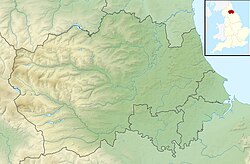| Butterby Oxbow | |
|---|---|
 Oxbow lake at Low Butterby | |
| Location | MAGiC MaP |
| Nearest city | Durham |
| Coordinates | 54°44′44″N1°34′25″W / 54.74556°N 1.57361°W |
| Area | 7.29 ha (18.0 acres) |
| Established | 1957 |
| Governing body | Natural England |
| Website | Butterby Oxbow SSSI |
Butterby Oxbow is a Site of Special Scientific Interest in County Durham, England. It consists of a former meander of the River Wear which was isolated from the main river in 1811 when, to reduce flooding in the area, a new channel was constructed across the neck of the meander. [1] It is located about 3 km south of the centre of Durham and 1.2 km north of the nearest village, Croxdale.
The site is notable for the succession series of swamp, fen and fen-carr which has developed and which is rarely found as a complete sequence in the county. It is locally important as a roosting and wintering area for wildfowl. [2]
